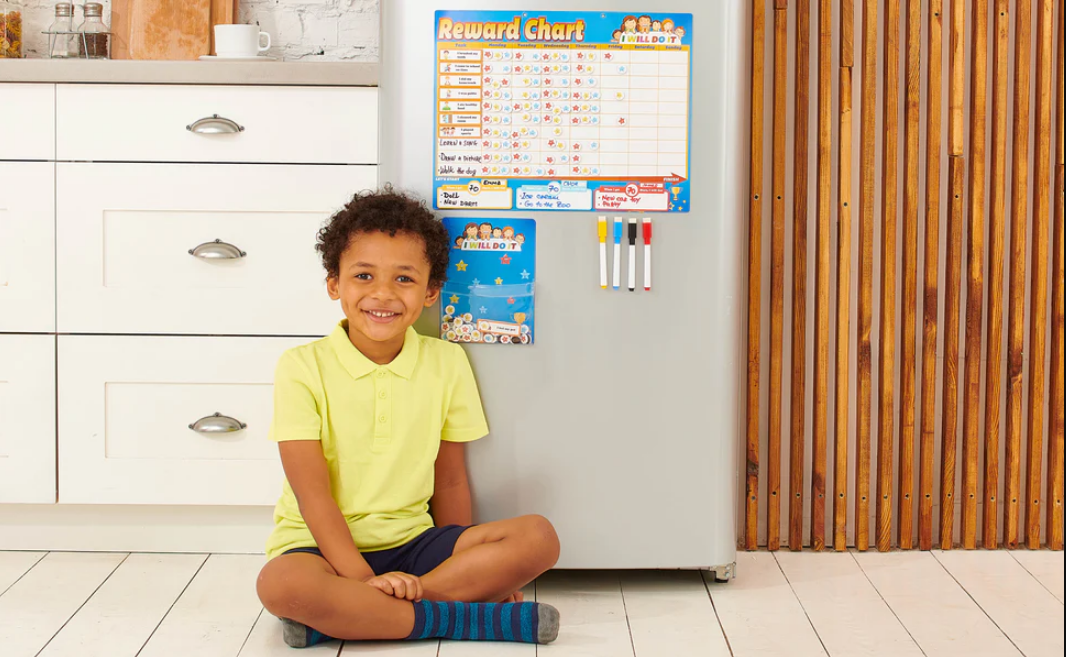Behavior charts are one of the fastest and easiest behavior modification tools available today. Most children love the immediate feedback these reward charts offer. It’s also designed to help them stay on track.
Keep in mind, the goal of behavior charts is not to embarrass or shame your child. Hearing a statement like, “you only got one sticker and your sister got five,” isn’t going to encourage your child to modify their behavior and do better in the future. The goal of a behavior chart is to slowly reinforce expected behaviors and to eliminate the back-and-forth argument that comes from debating undesirable behaviors.
The good news is, there are steps you can take to create a behavior chart that gives your family a behavior-shaping tool. Some tips to help you do this are found here.
How Behavior Charts Work
The concept is pretty simple. It is a piece of paper or cardboard with rows and columns on it. Behaviors you want your child to engage in are written on it. Examples are “finish homework”, “brush teeth”, “clean up toys”, or “hang up clothes after showering.” It can be a daily or weekly behavior chart. You and your child will keep track of how often each behavior is completed. A checkmark, stickers or smileys can be used to indicate the completion of each behavior. A reward is given for completing those set behaviors.
This may sound very simple. The success or failure of this behavior chart at home relies on how you implement them. So it is important to set a goal and know what steps you need to take to effectively engage your child.
Identify the Desired Behavior
Start by identifying what behavior needs to be addressed. Always start with something small. Choose three behaviors to address. This will help keep your child on track. Don’t confuse them by giving too many behaviors to engage in all at once. Be specific and let your child know exactly what you mean. For example, saying “be good” will not be effective since your child does not know what they should be good at. Use a positive tone when enforcing these behaviors. Gage these behaviors based on their age and maturity level.
Keep Your Child Involved
Let them choose the behaviors they want on the chart. They can also make the charts themselves, pick out stickers and decide on what reward they will get. Keep the chart visible, like on the fridge. This will help achieving the task easier since you and your child will often see the chart. If you have more than one child, keep a separate chart for each. It is crucial to keep the kids involved to make the behavior chart as effective as possible.
Determine How Often Good Behaviors Should Be Rewarded
Think about how often a child should be rewarded for their good behavior. For younger ones, a visual affirmation may be needed, like a sticker or a star to let them see their progress. Older ones may be able to wait for feedback at the end of the day.
It is your choice when to reward them. It can be in the mid-morning, late afternoon or nighttime. You can also divide it into three segments – before going to school, after school or before bedtime.
Use Short-term and Long-term Goals
Make multiple rewards – they can be immediate or long-term. For example, if your child earns three stickers, they get to have an extra ten minutes of TV time. When they earn ten stars or stickers, you get to take them out for pizza. If they are consistent and able to earn thirty stickers, they get to choose a new toy or something they have been wanting to have for a long time.
Determine a Meaningful Reward
Stickers and the subsequent reward may be effective enough to motivate your child, while some may opt to have larger rewards, especially if they are really behaving well. Finding a reward that helps motivate your child is important. They don’t need to be expensive rewards. There are affordable or free rewards you can give in exchange for good behavior. You may reward them by giving them the authority to choose a family game or some quality time together.
Change the reward as often as needed. Your child’s interests and maturity level changes over time. What motivates them this week may not be as meaningful in the following days. So, make sure that the behavior charts you create are updated too.
It is important to identify the reward that is meaningful enough to motivate your child. However, this doesn’t mean the reward has to be expensive. There are several low-cost and free rewards that are also extremely effective. Some low-cost examples that reinforce quality family time include: setting aside one hour of family time where your child gets to make the rules or choose the family game. It is also important to be sure to change the reward often, as your child’s interests and maturity level will change. What is a meaningful motivator one day may not be a meaningful motivator the next.
In conclusion, a behavior chart for kids that offers rewards is a good motivator for them to change and adopt the right behaviors. These are just some simple tips to help you with starting your own chart.

